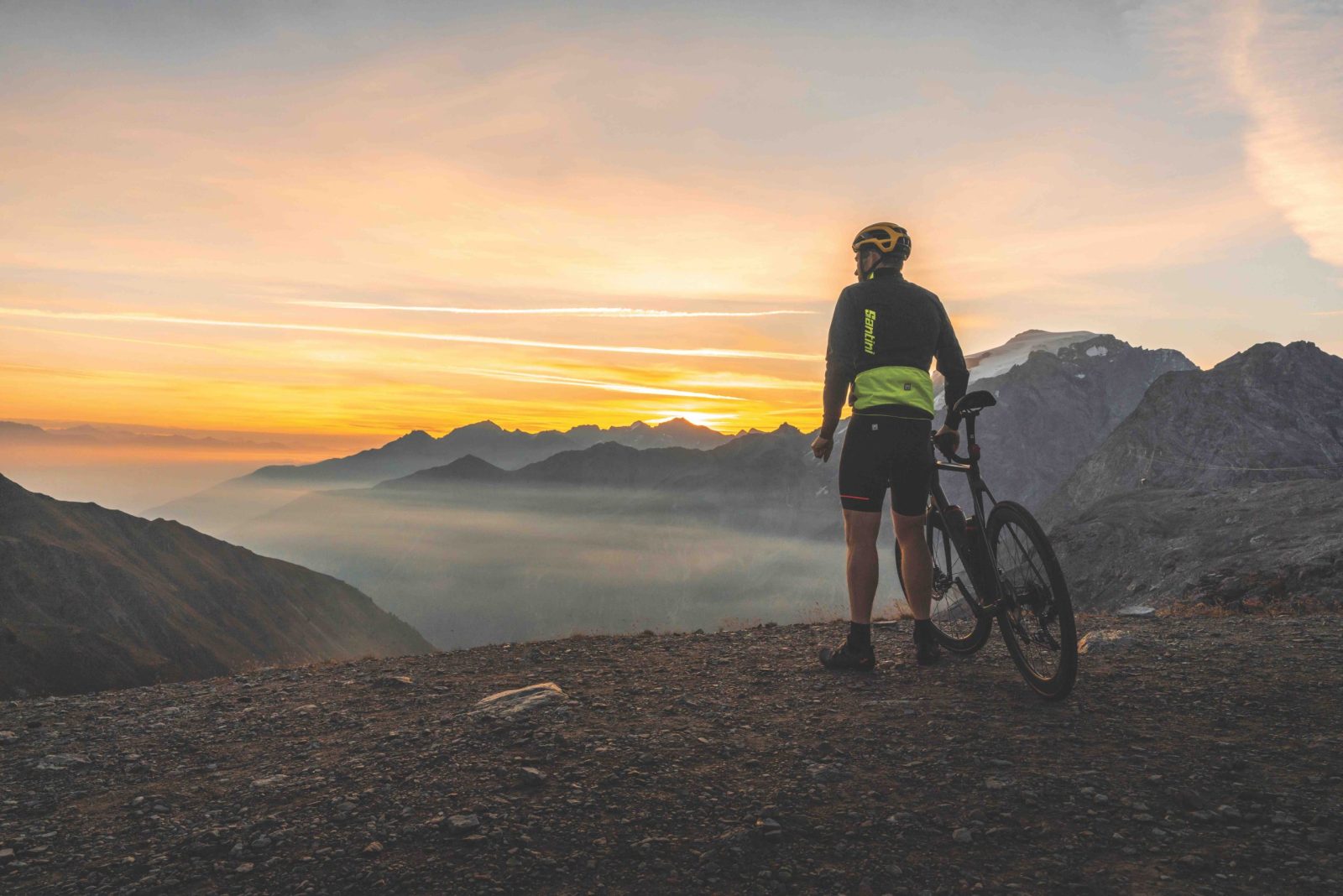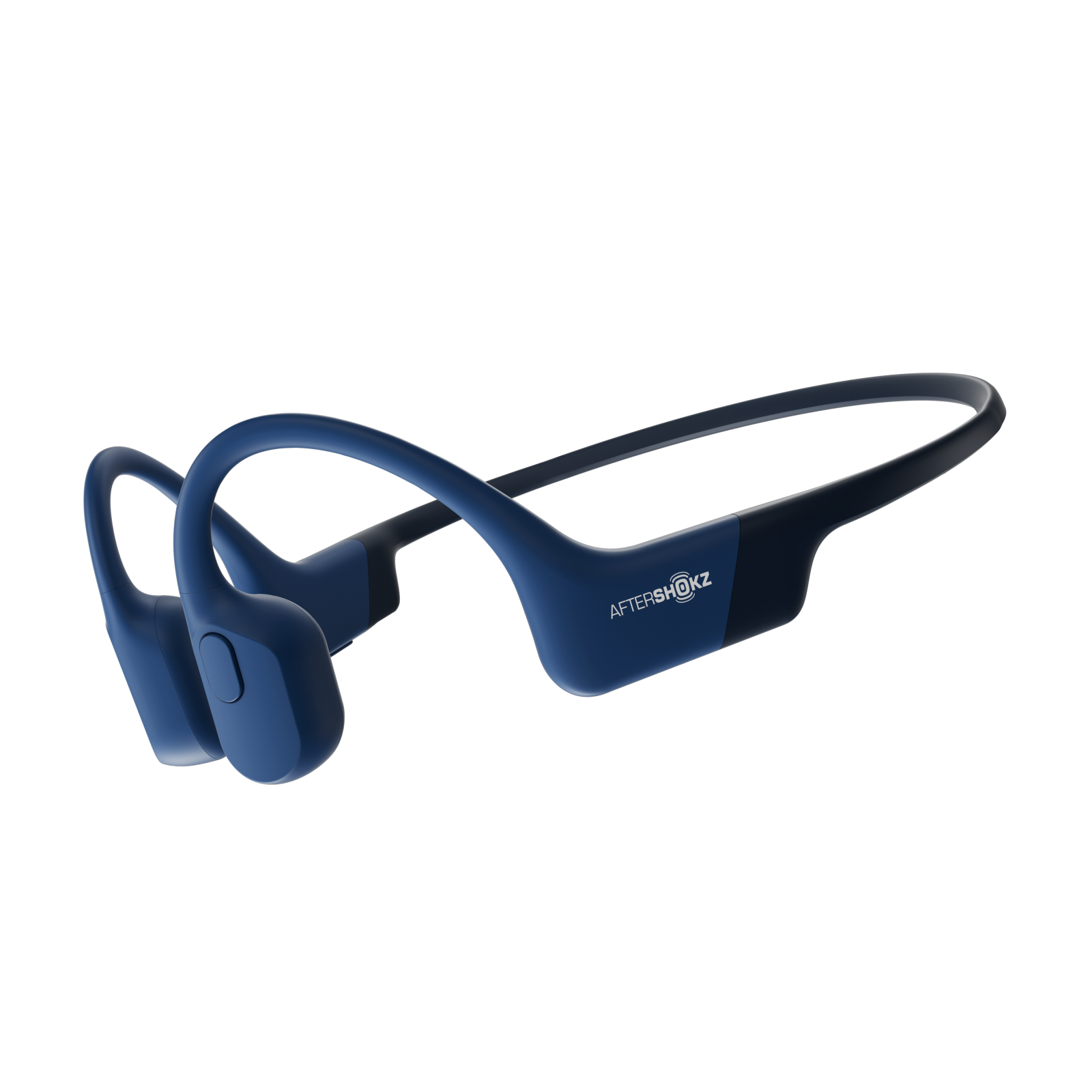In a decade of Cyclist there has never been a challenge like it: to ride up the Passo dello Stelvio not once, not twice, but three times, all in a single ride.
Words Marcus Leach
Photography Gavin Kaps / Osprey Imagery
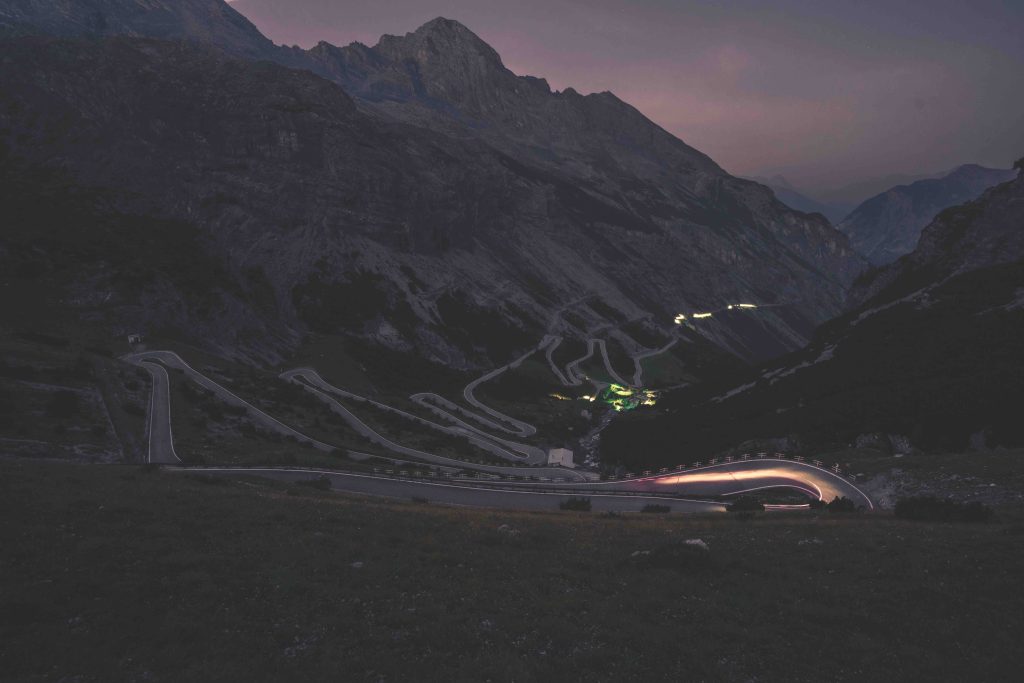
I’m roused by the shrill blast of my alarm, purposefully set to a maddening tone to ensure I wake promptly at 3:45am. An overwhelming urge to roll over and pull the doona over my head permeates my body. Still full of sleep, my eyes sting, although nowhere near as much as my legs will once the day is through.
‘Come on, there’s a mountain to be climbed.’
The little voice whispering inside my head is right, there is a mountain to be climbed, only it’s not just any old mountain. It’s the legendary Passo dello Stelvio. And that’s a serious undertaking as it is, but for today’s Big Ride, she’ll prove a beast thrice over. I’m struggling to remember why, given the early hour, but I’ve decided to climb it three times in one continuous ride.
Even by my standards, which are probably somewhat different to your everyday cyclist’s and which have definitely been warped by all manner of ridiculous cycling challenges, riding all three sides of this behemoth in a day is bordering on the ridiculous. So it’s a good thing I practised yesterday. A mere 12 hours ago I was rolling across the finish line of the Stelvio Santini Gran Fondo. You have to get the kays in.
I work my way through a bowl of cold porridge that I prepared the night before, put on my helmet and tighten my shoes in anticipation of what lies ahead.
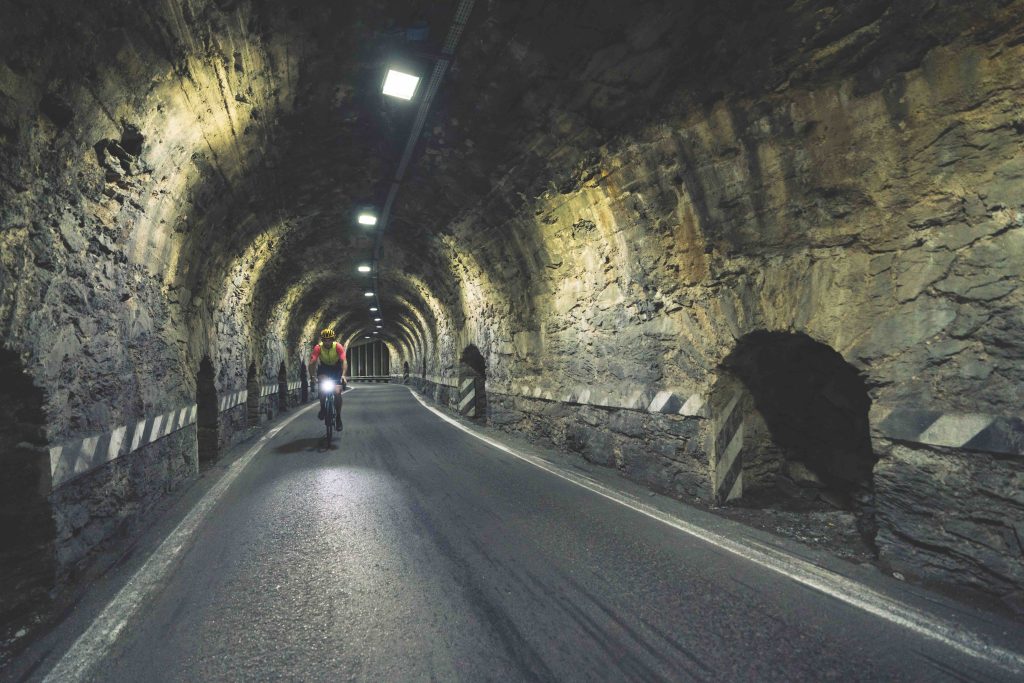
Get up, get out
Bathed in artificial light, the streets of Bormio are unsurprisingly empty as I set off, a solitary figure slowly disappearing into the night. There’s no easing into the ride, no opportunity to tick off a few quick kilometres or spin out heavy legs. It’s abruptly uphill from the very first pedal stroke. I coax myself through the first hour, focusing solely on forward momentum as my body and mind gradually come to life, thankful for the veil of darkness that hides the enormity of the landscape into which I’m heading.
Usually I find it easier climbing when I can’t see past the pool of light cast in front of my bike – what the eye can’t see can’t bedevil the mind – but on this occasion it feels different, the light sucking in the darkness as if the world is caving in around me, a feeling intensified by the sheer slabs of cold rock that lurk all around. I reach a series of dank tunnels that bore through the mountain, the air cool in comparison to the almost repressive heat outside of them. My presence triggers the sensors, activating great strips of powerful lights that send eerie shadows dancing along the walls.
Back in darkness the road rises steeply and, even though I can’t see it, I know I am heading for the iconic stepladder of switchbacks that leads up and out of the Braulio Valley. It’s here, as I methodically snake my way upwards, that the first fingers of light stretch out from behind the jagged mountains towering above. Ever so gradually the horizon is flooded with a pool of silvery light, my ears fill with the roar of water cascading down the out of sight Braulio waterfall, and with that a fresh optimism for the day washes over me.
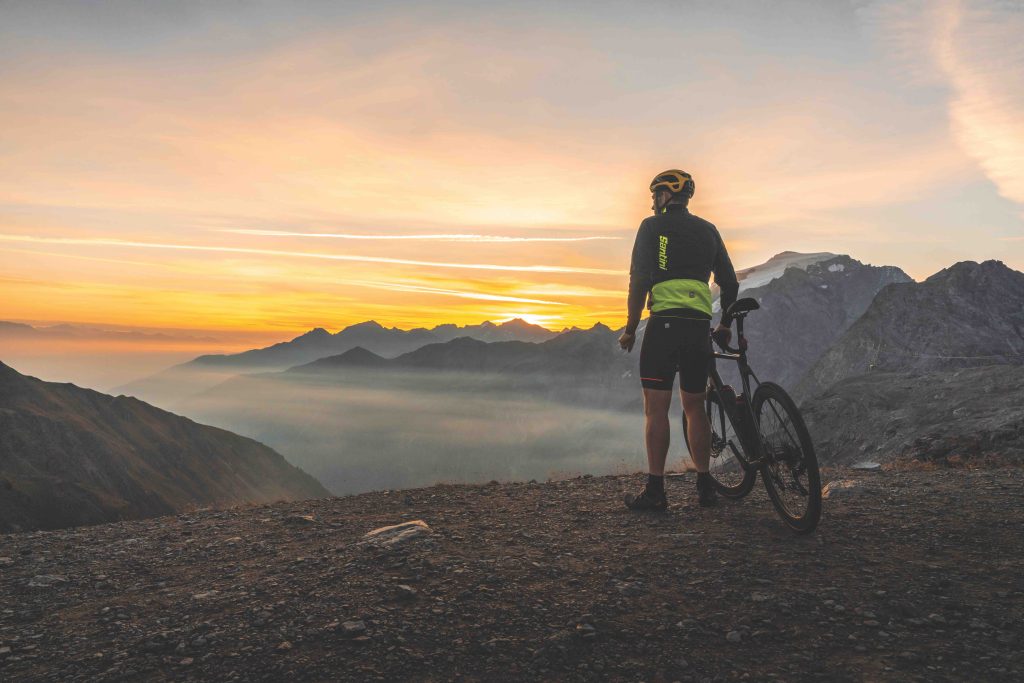
Falling down
The following 5km are not the hardest, comparatively speaking, yet with long stretches leading up through the Alpine meadows that sprawl across the plateau they drag on, slowly tightening their grip on my legs as I search for a steady rhythm. In the distance I can see the silhouette of buildings that sit atop the pass, a reminder that there’s still a long way to go. The temperature drops as I approach a series of meandering switchbacks that lead through an exposed, rocky landscape. I keep turning the pedals, trying not to think any further than the next corner.
I finally reach the Stelvio’s summit just as the sky is ignited by a kaleidoscope of colour, forcing me to stop and marvel. My tiredness melts away, replaced instead by a deep sense of gratitude. Each of us rides for different reasons and, for all my love of the physical challenge of the mountains, it’s this deeper connection with the natural world that fuels my desire to ride through the darkness. But I have to be practical. This is only ascent one out of three, and the longer I stand still the harder it will be to get going again. I clip in and roll off down the descent towards Prad am Stilfser Joch.
The dropping road is beautiful and smooth, but my mind is unable to shake the thought that every vertical metre I’m losing I’ll have to recapture on my second ascent. My body, on the other hand, can’t shake the cold. Despite wearing several layers I’m shivering like a leaf in a gale, struggling even to ride in a straight line. I’m desperate to be down in the valley, or I’d even settle for riding back up – at least that way I’d be generating some heat.
Arriving into Prad am Stilfser Joch, I’m in desperate need of sugar and caffeine, so I find a cafe and tuck into a canteen’s worth of coffee, hot chocolate and pastries. I’m sorely tempted to linger, to savour my breakfast in the morning sun and to forget my next ascent, which I know full well to be the hardest of the three. It takes all my mental resolve to quell that temptation and, having finished the last of my three delightful pastries, to get back on my bike and start pedalling again.
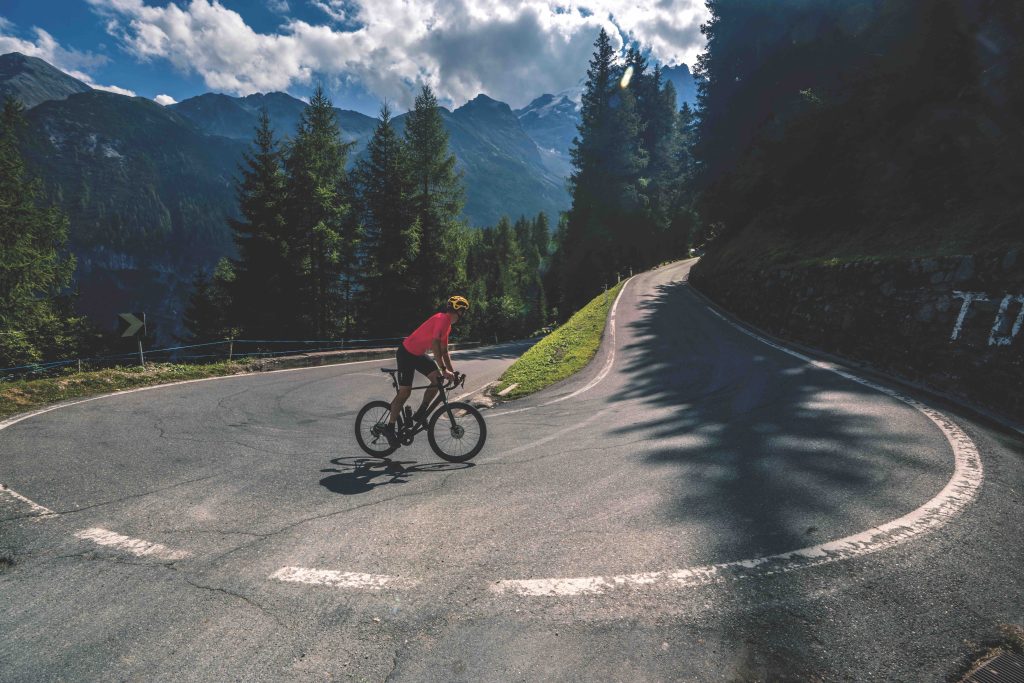
Impossible beauty
It takes a few kilometres for my legs to warm again to the task, but mercifully this road in earnest is not too steep, meandering along the lower stretches of the valley, the waters of the Rio Solda rumbling beside me. Ahead lies more than 1,800m of ascent and some of the most iconic switchbacks in the world, 48 in total, on a ribbon of road that is woven into the history of cycling.
Constructed back in the 1870s and taking 2,500 men five years to build, this section of the Stelvio is an unrivalled feat of engineering that earned its chief engineer, Carlo Donegani, the title of progettista dell’impossibile, ‘designer of the impossible’.
As I reach the little hamlet of Trafoi a vast panorama opens before me, a curtain pulled back on the snowy peaks that I had stood looking over earlier in the day. From here they look insurmountable and my mind starts to question the plausibility of what I’m asking my body to do. I’m no stranger to such thoughts and so I know there is only thing I can do: keep pedalling, one small step at a time, bargaining with that voice of unrest, promising it anything it desires other than stopping. Which right now is all manner of delectable food.
Corner by ever-steepening corner I work my way deeper into the belt of forest that carpets the middle of the mountain. Despite having only passed through a few hours earlier I had forgotten just how steep some of these stretches are, and my legs strain against the slope of the road as it repeatedly kicks up out of every corner, thankful for the umbrella of branches above that prevent the sun from adding to my woes. As the trees start to thin, one of cycling’s most intimidating views appears before me, one that can crush spirits or, as has been the case throughout the Giro d’Italia, inspire greatness. Looking up at the vertical wall of rock that the final stretch of road sticks to like a piece of contorted linguine, it’s easy to see why Donegani was given such a title.
I wonder how many cyclists have, like me right now, craned their necks to look to the summit and questioned how they will ever make it to the top. From here there’s still another 600m metres of vertical ascent and an almost incomprehensible 23 hairpin bends to twist and turn my way through. I’m reminded of the advice I was given when I climbed Mount Kilimanjaro: pole, pole, which translated from Swahili simply means ‘slowly, slowly’. With that one word in my head I train my focus on the next corner, counting pedal strokes in a bid to forget about everything else.
Near the top the Stelvio’s corners become tighter and the road more mesmerising, and I find myself pushing harder on the pedals, spurred on by ghosts of the past, thoughts of the greats who have ridden this hallowed ground carrying me higher. Into the final turn and for the first time I allow myself to look back down the valley. Lost in the moment I sprint for the summit, forgetting that this isn’t the finish, at least not yet.
Passing through the gauntlet of stalls and shops that line the road at the top, my nostrils are filled with the alluring smell of hot dogs and fried onions. That little voice reminds me of my earlier promise, but I don’t stop. This is only two out of three. Food must wait.
Once more the descent proves to be the hardest part, time enough for my thoughts to become increasingly apathetic as I plunge back down the mountain on a pristine road. It’s the passing of a Swiss flag blowing in the wind that lifts my mood and reminds me of my little boy’s favourite joke* and I laugh out loud, a reminder of a world beyond this mountain. It’s the mental release I need before switching back on, ready for the third and final climb.

The last gasp
Mercifully the road from the little Swiss village of Santa Maria is the easiest of the three, measuring ‘just’ 16.5km and with ‘only’ 1,373m of ascent to the Stelvio’s 2,758m. Not that anything is easy when you’ve clocked over 3,000m of total elevation over back-to-back hors categorie climbs. But at least from a mental perspective it’s more manageable. By now I’m almost impervious to the constant ache in my legs, allowing my mind to revel in the serene beauty of my surrounds instead, knowing that I will, in good time, reach the summit again.
There’s a distinctly different feel to this side of the mountain, a more traditional Alpine setting with rolling pastures leading up to forests of pine, a river gushing past as cows amble along, their bells clanging and tails swatting away flies.
Next a stream of motorbikes roars past, the guttural sound of their engines reverberating through the valley as they disappear into the folds of the mountain. It’s hard not to envy the ease with which they move as I lurch forward out of the saddle, calling on every muscle fibre to combat the growing steepness of the road as it cuts back on itself for the umpteenth time.
By the time an understated sign appears signalling the summit of the Umbrail Pass, the point at which this road rejoins the Stelvio’s ascent from Bormio, some 11 hours have passed. I’m incredibly close, but unlike when I set off in the dark this morning, I’m no longer alone. Several cyclists pass me as the last kilometres come and go, the urge to tell them this is my third ascent of the day dwindling with each one that races away. I keep pedalling at my own pace, content in the knowledge I haven’t done this to impress but rather for the love of riding my bike; for the freedom, the gradual ascension away from everyday life to a place where happiness sits atop a mountain. And not just any old mountain.
Marcus Leach is a professional masochist whose son’s favourite joke is: *What’s the best thing about living in Switzerland? I don’t know, but the flag is a big plus
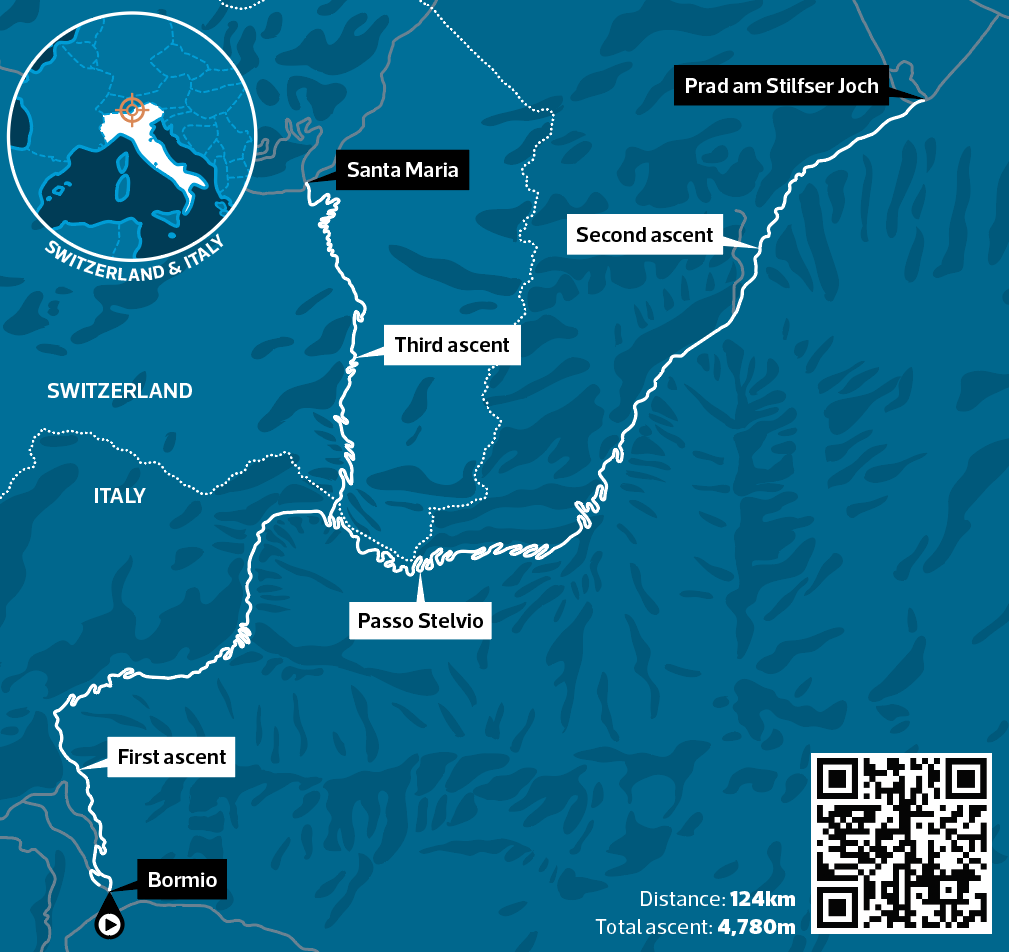
To download this route go to komoot.com/tour/466706670 or scan the QR code. Should you wish to take on this challenge yourself, we advise you start in Bormio. From here take the SS38 and follow it all the way to the summit of the climb – the high point of the Stelvio Pass – cresting the top and continuing on the same road all the way down to Prad am Stilfser Joch. It would be wise to stop for a coffee and cake here before turning around and heading back up the SS38 until once again you reach the summit. Descend back towards Bormio for around 3km and turn right by the Casa Cantoniera dello Stelvio. Descend to the end of the road in Santa Maria. Once again, we advise a fuel stop before turning around and starting the final ascent back to the Casa Cantoniera dello Stelvio, taking a final left turn and continuing to the summit of the mountain. Hot dogs and a sanity check await.

